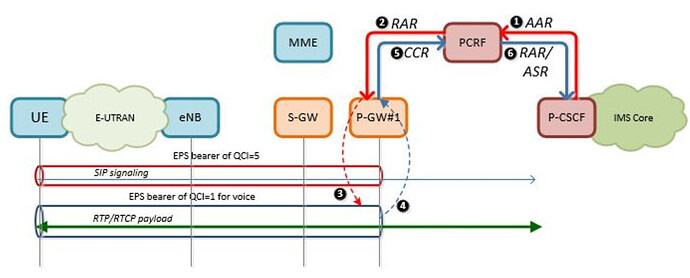In a previous post, we explored the VoLTE call flow and how QCI 1 and QCI 5 enable high-definition voice and seamless signaling. Today, let’s focus on a critical segment within the flow: Steps 1 to 6 in the picture, which showcase the interaction between the P-CSCF, PCRF, and P-GW in managing policy control and resource allocation
Steps 1 to 6: Simplified Explanation
-
AAR (Authorization and Authentication Request):
The P-CSCF (Proxy Call Session Control Function), part of the IMS core, sends an AAR message to the PCRF (Policy and Charging Rules Function). This step ensures that the network understands the QoS (Quality of Service) requirements for the VoLTE session.Think of the AAR as a “request” for approval to set up resources needed for a high-quality VoLTE call.
-
RAR (Re-Authorization Request):
The PCRF, acting as the brain of policy control, evaluates the AAR and sends a RAR to the P-GW (Packet Gateway). This step instructs the P-GW to create or update the bearers that will carry the voice and signaling traffic. -
EPS Bearer for QCI 5 (SIP Signaling):
The P-GW sets up an EPS bearer with QCI 5, which is specifically used for SIP signaling. This bearer handles the communication needed to set up, manage, and terminate the call.Example: When you hit “Call,” the SIP signaling ensures the call gets connected to the other party.
-
Acknowledgment to PCRF:
The P-GW sends an acknowledgment back to the PCRF, confirming that the signaling bearer is ready and QoS rules have been applied. -
CCR (Credit Control Request):
The P-GW notifies the PCRF about resource usage and the service being delivered through a CCR message. This step is crucial for charging and policy enforcement.It’s like reporting back to ensure that the resources being used align with what was approved.
-
RAR/ASR to P-CSCF:
Finally, the PCRF sends a RAR (Re-Authorization Request) or ASR (Answer to Session Request) to the P-CSCF, confirming that all policies are implemented, and the VoLTE session can proceed smoothly.
Why These Steps Are Critical for VoLTE
-
Dynamic QoS Management:
The interaction between the P-CSCF, PCRF, and P-GW ensures that resources for both signaling (QCI 5) and media (QCI 1) are allocated dynamically and efficiently. -
Seamless SIP Signaling (QCI 5):
QCI 5 ensures reliable, low-latency signaling, enabling quick call setup and smooth session management. Without this, calls may fail to connect.
LinkedIn: ![]()
